
Use the 'back' button on your browser to return, if necessary.
Related Pages
Flowers are in the business of attracting pollinators. Many pollinators such as bees and syrphid flies not only see colors in visible light, but also can see in the ultraviolet spectrum ('below' the purples in wavelength). Many flowers that seem to us to be just plain white or yellow, have markings in the ultraviolet spectrum that make the location of the flower's landing-zone more apparent, but may also help bees and others tell flowers apart, because bees tend to stick to a certain species of flower for a time (and it's in the best interest of pollen-producing plants).
Although honey bees see mostly the same colors we do, they can only differentiate between six major categories of color, including yellow, blue-green, blue, violet, ultraviolet (below purple), and also a color known as "bee's purple," which is a mixture of yellow and ultraviolet. To the best of our knowledge, bees can not see red. They see best in the blue-green, violet, and bee's purple color ranges.
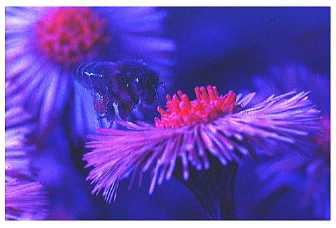 |
|
This is probably closer to the colors that a bee sees as it watches another bee land near a Colt's Foot Flower (Tussilago farfara), though with the nature of a bee's eye, is decidedly not WHAT it sees. This image, and all UV photography on this page is copyright © Bjørn Rørslett-NN/Nærfoto whose great pages on UV nature photography can be found at www.foto.no/nikon/ |
Interestingly, bees have compound eyes. Thru investigation, it seems probably that the advantage of the compound eye is its ability to detect movement. Honey bees can easily differentiate between solid and broken patterns, but show a preference for broken figures. It would seem that their eyes are better adapted to perceiving movement rather than form. Related to this, bees seem to respond more readily to moving flowers than to stationary ones. It may be why many flowers are also delicate in nature and move easily with the wind (I know this from trying to photograph them in the field).
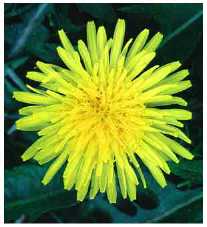 |
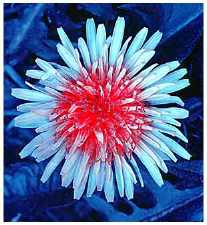 |
|
The common dandelion (Taraxacum officinale) reflecting visible light (on the left) and reflecting light in the ultraviolet range (on the right). Since the green leaves of the plant are busy absorbing UV light, they provide a rich dark background for the lighter circle of reflective petals of the flower. The center disk color may help provide a strong landing pad pattern for any possible pollinators. Both photos © Bjørn Rørslett-NN/Nærfoto. | |
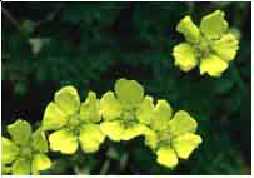 |
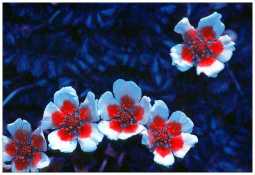 |
|
Here we have a relative of the cinquefoil, the northerly Silverweed, Potentilla anserina. A very pretty, distinct UV pattern emerges. Certainly, bees are going to be able to distinguish these (and discriminate appropriately). Both photos © Bjørn Rørslett-NN/Nærfoto. | |
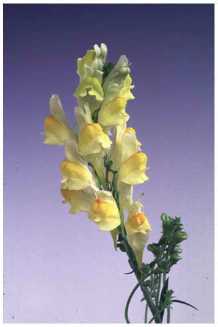 |
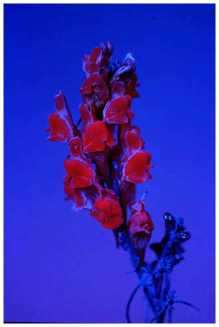 |
|
Lest you begin to conclude that all yellow and white flowers have discernable UV patterns, here's Bjørn Rørslett's photos of that Snapdragon family favorite, Butter and Eggs (Linaria vulgaris). Certainly knowing where to enter these flowers are just as important, if not more so, than other yellow flowers, yet the UV reflection only serve to help locate the flower inflorescence, not the entrances to each. Both photos © Bjørn Rørslett-NN/Nærfoto. | |
In the above case of Butter and Eggs, the UV pattern may suffice to attract many different bees and flies, but the plant selects out only those pollinators of just the right size and weight. The preferred pollinators are the ones able to trigger the flower to open, while all others are excluded. This helps ensure that a specific pollinator that specializes in carrying pollen from other Butter and Eggs is the only one to gain entry. This strategy may be used for plants that flower during the time of year when there are many other flowers blooming at the same time.
ALSO OF NOTE
I found one reference to a spider that uses UV strands of its web to possibly mimic the landing pattern of a flower, thus attracting nectar-foraging prey such as bees and flies directly into its trap. I could not find out what type of spider nor what type of flower it imitated, so this may just be speculation on someone's part. However, given that nature, in all her beauty and diversity, usually leaves no niche unexplored, i don't doubt the possibility.
Interestingly, we are finding out that UV colors may communicate a wide variety of information for animals that can see it. Among them, butterflies seem to use UV patterns to be able to tell their sexes apart, and female blackbirds may use the ultraviolet sheen of males to help select the best mate. I'm sure the list goes on and on.
NOTE: All UV photography on this page is copyright ©
Bjørn Rørslett-NN/Nærfoto. His UV nature
photography website can be found at www.foto.no/nikon/